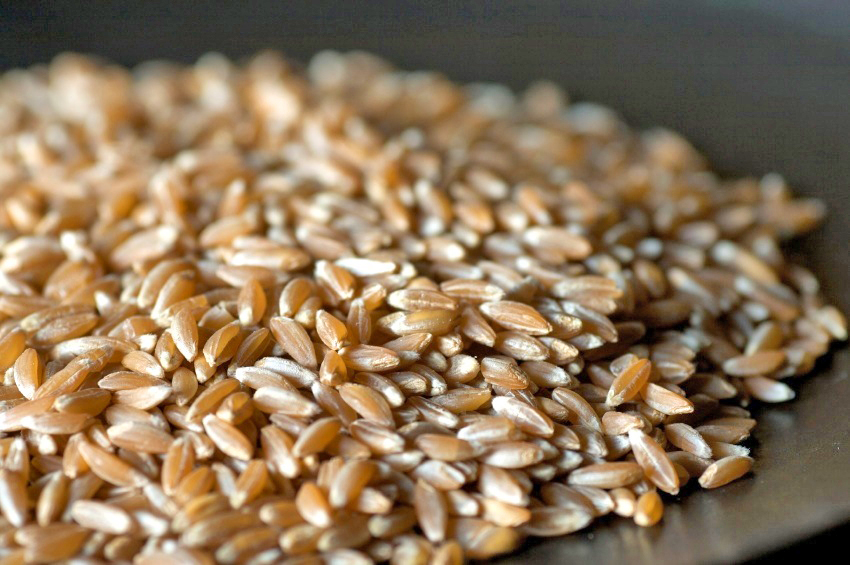Creamy and rich, with a soul satisfying flavor, this farro salad is going to become one of your favorite recipes! Using the same technique as risotto, farro is easier to work with than Arborio rice. You can use it as a side dish or make it a vegetarian/vegan entree with a few adjustments. Your family and guests will think they are eating at a fine restaurant when you serve this dish!
We have heard a lot lately about how good whole grains are for us. Unlike highly processed grains like white rice, they are left in their natural state and are a good source of protein, vitamins, minerals and fiber. All of that is interesting, but what I really care about is that they are delicious! Brown rice, barley, rye, oats, and Farro are a few of the different grains available today. Chewy with a nutty character, they are a tasty change from the ordinary rice or pasta we are used to.
This is one of my true “go-to” recipes. I usually sauté the standard mirepoix combination of onions, celery, and carrots as the base for this dish to create a pilaf. You can add any vegetables that you have on hand. These might include zucchini, yellow squash, tomatoes, bell peppers, chile peppers, or cucumbers. Anything that needs to be cooked can be added at the same time as the onions. For delicate vegetables like tomatoes and cucumbers, I stir them in just before serving. Because of the saltiness of Parmesan cheese you should not have to add any additional salt, but taste and adjust to your liking. I alter the seasonings to match the entrée I’m making, adding herbs such as oregano, basil, thyme, or rosemary. This makes a large amount and I usually have leftovers. The next day I like to form patties and fry them for breakfast for a nice change from potatoes.

Raw Farro
Farro is an ancient grain, originating in the Mediterranean countries thousands of years ago. When you are preparing it, make sure you sort through it carefully and discard any bits of chaff, pebbles, or spoiled grains. Then rinse it thoroughly. Depending on the type you buy, the producer may suggest you soak it in water for 8 hours or overnight. Do that and then continue with recipe directions below. Just know that you may have to adjust the cooking time. Of course, you can substitute any grain you like for the farro. Bulgar would be delicious, as would quinoa, millet, or wheatberries.
The other major component of today’s dish is Parmigiano Reggiano (Parmesan) cheese. Its nutty flavors marry perfectly with the farro. It gets its name from the Emilia-Romagna region of Italy where it is produced. Anything made outside of this distinct area, while still delicious is not considered true Parmesan and is called Grana Padano. Buying a good quality cheese and grating it yourself is so easy and tastes so much better than the cheese sold in the green can, that you owe it to yourself to buy it fresh.

Parmesan Cheese
The graters made by Microplane make grating anything a joy and give you the perfect texture. They come in a variety of styles that produce zest or shreds from feathery to thick strands. The first time I tried one I could not believe how perfectly it grated items. I now own three in different sizes. I can’t even imagine zesting citrus without one. They are not expensive, last forever, and will become one of your favorite tools.
The beauty of this recipe is that you can leave it as simple as you like, change it to suit the season, or add in vegetables you have in your refrigerator. Infinitely adaptable, it is the perfect side dish or a delicious stand-alone entrée. If you make it with vegetable stock it is vegetarian and if you leave out the cheese it is vegan. Serve this with assorted herb roasted vegetables for a hearty and healthy meal.

Farro Salad with Tomatoes
Jane’s Tips and Hints:
It may seem like a little thing, but using a pepper grinder and grinding your pepper fresh makes a huge difference, especially in dishes like this where there are few ingredients. Grinders are adjustable so you can go from a very fine grind all the way up to cracked pepper. I like a blend of peppercorns and use the Four Peppercorn Blend from Penzey’s Spices.


- 1 medium onion, finely minced 2 tbsp olive oil
- 1 cup dry Farro
- 1/4 cup dry white wine* or dry vermouth
- 1/4 cup water
- 3 cups chicken stock (or vegetable stock for a vegetarian option)
- 1 cup water
- 1/2 cup grated Parmesan or Monterey Jack cheese, or a combination
- 1 tsp dried thyme or 2 tsp fresh thyme leaves
- 1 tsp dried oregano
- Freshly ground black pepper
- 1/4 cup finely minced chives or fresh thyme
- Grated Ricotta Salata cheese, optional
- Combine the water and chicken stock (or vegetable stock) in a medium saucepan and bring to a simmer. Keep warm on a back burner while you sauté the onions.
- In a heavy bottomed pan over low heat, sweat the minced onion in olive oil until translucent. When the onions are softened, add the farro and slowly toast until it becomes aromatic, it will smell a little like toasted bread. Add the white wine and water, and cook until dry. Slowly add small ladles of the hot chicken stock to the farro allowing the liquid to be absorbed before adding more, stirring occasionally. Make sure you leave a ladle-full of stock in the pan – you’ll use it in a minute. Season lightly with pepper.
- Cook until the farro is tender and remove from the heat. Add one ladle of stock and fold in the Parmesan cheese, thyme and oregano. Blend thoroughly. Taste and add pepper if desired. Stir to break up any strings from the cheese. Add more stock if desired. Sprinkle with the minced chives or thyme and cheese if desired, and serve.
- *If you are making this for children, they would probably prefer it without the wine. Just replace it with additional water or stock.
Thank You!







Kay @ The Church Cook
This recipe looks absolutely yummy! I can almost taste the melded flavor of herbs & cheese in rich broth and wine! 🙂
Jane Bonacci, The Heritage Cook
Thank you Kay!